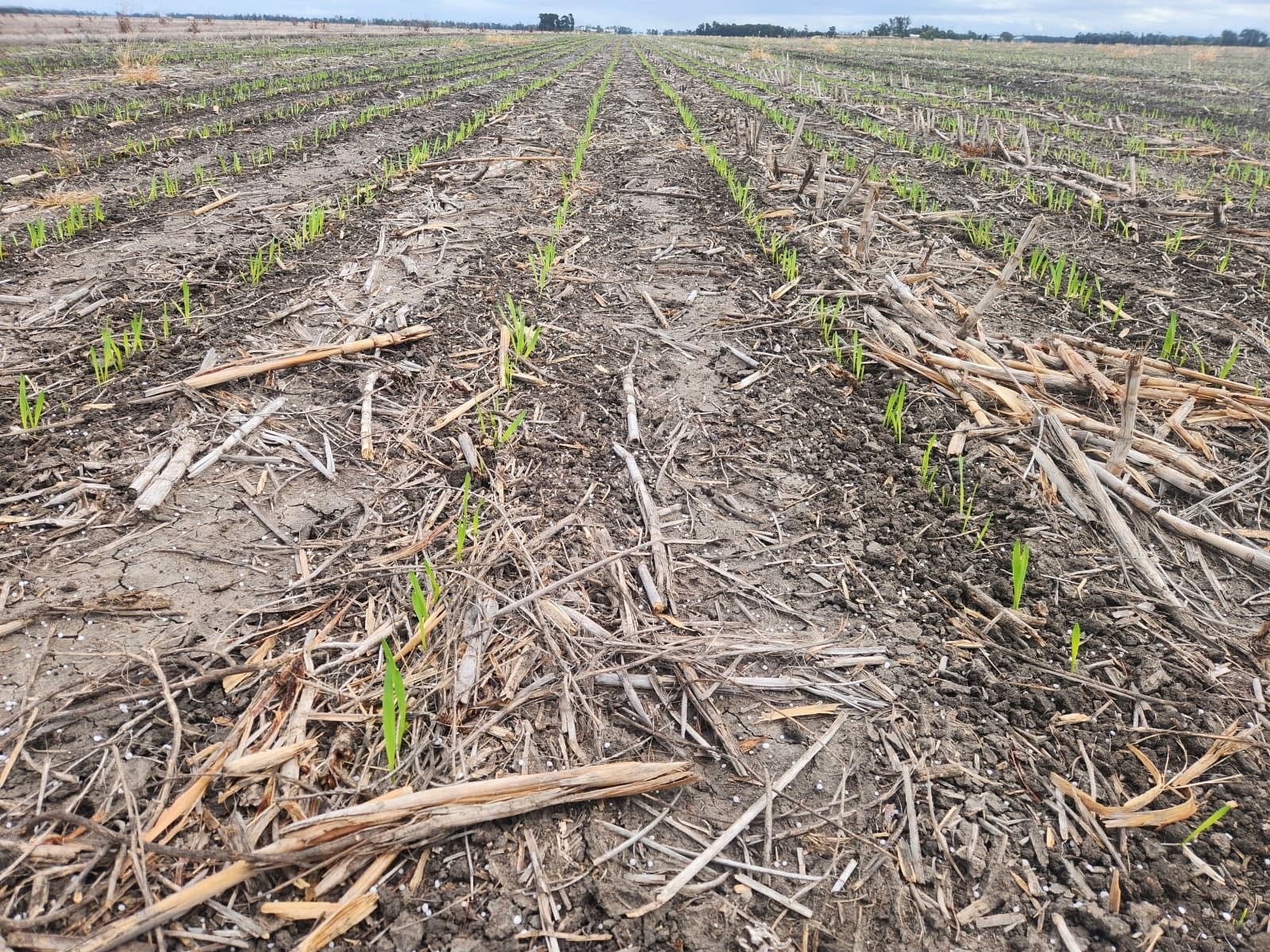
A crop of Neo CL barley off to a strong start at Warra on Qld’s Darling Downs after planting last week. Photo: Matt Naumann, InterGrain
CONSUMER and grazier demand for wheat and barley has lifted values this week as soaking rain continues to elude the forecast for south-eastern Australia.
Prices delivered Melbourne have jumped by up to $15 per tonne, as against $2-$3/t in Queensland and northern New South Wales, where winter crops are being sown in generally ideal conditions.
Dry sowing in South Australia, Victoria and southern NSW is well advanced, and pointing to a swing out of canola and faba beans and into barley.
Export demand has softened for sorghum, partly in response to seemingly improved US-China trade relations, and for barley also as unsold stocks out of SA and eastern states tighten.
| May 8 | Today | |
| Barley Downs | $332 | $334 |
| ASW Downs | $350 | $353 |
| Sorghum Downs | $360 | $353 |
| Barley Melbourne | $367 | $382 |
| ASW Melbourne | $370 | $385 |
Table 1: Indicative prices in Australian dollars per tonne.
Northern growers planting, holding
Nutrien Ag Solutions Dalby agronomist Ross Pomroy said planting of winter crops on the Downs was off to a strong and early start.
“Because of the moisture we’ve had coming into April, we’ve had some very early barley and some early wheat gone in,” Mr Pomroy said.
“It’s vastly higher than normal and vastly earlier than normal but we are obviously trying to utilise that soil moisture.”
In line with GRDC’s warning to growers issued this week, Mr Pomroy said mouse numbers increased at the end of the sorghum-growing season.
“Baiting was required in the later sorghum crop that’s for sure.”
Trade sources report that grain from northern NSW is now making its way into the SA drought market, with loads of wheat from Walgett among those marking a reversal of the normal south-to-north flow.
One trader said northern growers were generally well sold on sorghum, busy planting winter crops, and eyeing the expanding southern drought market.
“Exporters on bulk sorghum cargoes don’t want to put their toes in the water until they evaluate what’s left on farm.”
He said the drawing arc of the southern drought market had moved north in recent weeks, and was now close to the Qld-NSW border.
At Gunnedah, Quest Commodities principal Jayne Barker said the barley market has a firm tone.
“It’s that time of year; there’s a bit of a squeeze with growers sowing,” Ms Barker said.
Barley delivered Liverpool Plains is trading at around $320-$325/t, while SFW and ASW wheat is sitting at around $340/t.
Sorghum sales have slowed as harvest winds up, with the delivered Newcastle market trading earlier this week at around $388/t.
“On sorghum, exporters are trying to finish off their export commitments,
“Sorghum isn’t selling as much as it could be.
“If we get rain in the next couple of days, there could be a bit sold when growers have time to market it.”
Southern growers go to ground
Despite only a few millimetres of rain being in the forecast for south-eastern Australia in the next eight days, growers are dry sowing at pace, and some have finished, or are close to it.
Others have made a tentative start, and a few are looking at replanting some poorly germinated canola or cereals after only light falls since sowing.
However, some crops are up and away if they jagged 10mm or more of rain.
In SA, AW Vater & Sons principal trader Kim Vater said a great deal of the intended SA crop has been sown dry, although canola and faba bean area appears to be dropping in favour of Clearfield wheat and barley to be planted later.
Concerns about residual herbicide after a very low-rainfall growing season in 2024-25 have Clearfield oats varieties also in demand.
Talk is starting to filter through that lentils too are being reduced or dropped in intended area as growers eye their own or others’ drought demand for oats and barley which can be grazed, cut for hay, or harvested for grain.
“The worst problem is no one has ever seen a season like this before; we’ve had no summer rain, and there is absolutely no subsoil moisture.”
SA’s export program is still chugging along, and unsold barley is making its way to local livestock markets.
“Barley’s being picked up for on-farm use, and we’ve had inquiry from sheep lotfeeders; there still seems to be confidence in the sheep job.”
SA barley is selling on-farm at around $335/t, and wheat is in short supply and selling at closer to $355/t.
Lupins have gotten very hard to find in SA and are priced at around $700/t landed, hay prices have increased, and Mr Vater said almond hulls “have gone through the roof” as roughage is sought to add to grain for livestock rations.
Almond hulls are quoted at $200-$230/t ex plant, up from their usual level of around $80-$100/t.
As the anxious wait for the autumn, possibly rolling into winter, break arrives, the feed gap looks set to last for some weeks at least, provided weather is warm enough to allow crops to pile on some growth once it does rain.
“It doesn’t matter whether you sowed a month ago or in two weeks’ time, it’s all going to germinate at once.”
At Wagga Wagga, Peters Commodities trader Peter Gerhardy said growers who have sown dry were anxious about getting on 5-8mm in the next fall.
“It it’s 20mm, happy days,” Mr Gerhardy said, adding that some Riverina growers were up to 80pc done, while others were half through and waiting for rain, and others were yet to make a serious start.
“Some thought they’d get some sheep feed out of what they’ve planted, and found their canola’s come up, and cereals too, and they’ve started to die because they don’t have the moisture.”
“If their canola doesn’t come up, they’ll resow with barley.“
Mr Gerhardy said growers have “jammed right up” in terms of selling to the trade, and even rain in coming weeks is not expected to depress prices with a continuing feed gap likely over mid-winter.
“What we are seeing a lot of is farmer-to-farmer trade; everyone wants a load for sheep or cattle.”
“Mixed farmers normally have sheep on crops by now; not this year.”
Stockfeed manufacturers are said to be working flat out to satisfy demand from the ruminant market, with barley delivered Goulburn Valley in the low $370s.

HAVE YOUR SAY